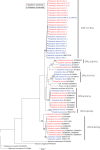Continent-wide distribution in mycorrhizal fungi: implications for the biogeography of specialized orchids
- PMID: 26105186
- PMCID: PMC4549956
- DOI: 10.1093/aob/mcv084
Continent-wide distribution in mycorrhizal fungi: implications for the biogeography of specialized orchids
Abstract
Background and aims: Although mycorrhizal associations are predominantly generalist, specialized mycorrhizal interactions have repeatedly evolved in Orchidaceae, suggesting a potential role in limiting the geographical range of orchid species. In particular, the Australian orchid flora is characterized by high mycorrhizal specialization and short-range endemism. This study investigates the mycorrhizae used by Pheladenia deformis, one of the few orchid species to occur across the Australian continent. Specifically, it examines whether P. deformis is widely distributed through using multiple fungi or a single widespread fungus, and if the fungi used by Australian orchids are widespread at the continental scale.
Methods: Mycorrhizal fungi were isolated from P. deformis populations in eastern and western Australia. Germination trials using seed from western Australian populations were conducted to test if these fungi supported germination, regardless of the region in which they occurred. A phylogenetic analysis was undertaken using isolates from P. deformis and other Australian orchids that use the genus Sebacina to test for the occurrence of operational taxonomic units (OTUs) in eastern and western Australia.
Key results: With the exception of one isolate, all fungi used by P. deformis belonged to a single fungal OTU of Sebacina. Fungal isolates from eastern and western Australia supported germination of P. deformis. A phylogenetic analysis of Australian Sebacina revealed that all of the OTUs that had been well sampled occurred on both sides of the continent.
Conclusions: The use of a widespread fungal OTU in P. deformis enables a broad distribution despite high mycorrhizal specificity. The Sebacina OTUs that are used by a range of Australian orchids occur on both sides of the continent, demonstrating that the short-range endemism prevalent in the orchids is not driven by fungal species with narrow distributions. Alternatively, a combination of specific edaphic requirements and a high incidence of pollination by sexual deception may explain biogeographic patterns in southern Australian orchids.
Keywords: Australia; Orchidaceae; Pheladenia deformis; Sebacina; biogeography; fungi; mycorrhizae; specialized; symbiosis.
© The Author 2015. Published by Oxford University Press on behalf of the Annals of Botany Company. All rights reserved. For Permissions, please email: journals.permissions@oup.com.
Figures


Similar articles
-
Continental-scale distribution and diversity of Ceratobasidium orchid mycorrhizal fungi in Australia.Ann Bot. 2021 Aug 26;128(3):329-343. doi: 10.1093/aob/mcab067. Ann Bot. 2021. PMID: 34077492 Free PMC article.
-
Specific mycorrhizal associations involving the same fungal taxa in common and threatened Caladenia (Orchidaceae): implications for conservation.Ann Bot. 2020 Oct 6;126(5):943-955. doi: 10.1093/aob/mcaa116. Ann Bot. 2020. PMID: 32574356 Free PMC article.
-
Mycorrhizal preference promotes habitat invasion by a native Australian orchid: Microtis media.Ann Bot. 2013 Mar;111(3):409-18. doi: 10.1093/aob/mcs294. Epub 2012 Dec 28. Ann Bot. 2013. PMID: 23275632 Free PMC article.
-
Deception above, deception below: linking pollination and mycorrhizal biology of orchids.J Exp Bot. 2008;59(5):1085-96. doi: 10.1093/jxb/erm366. Epub 2008 Mar 2. J Exp Bot. 2008. PMID: 18316318 Review.
-
Further advances in orchid mycorrhizal research.Mycorrhiza. 2007 Sep;17(6):475-486. doi: 10.1007/s00572-007-0138-1. Epub 2007 Jun 21. Mycorrhiza. 2007. PMID: 17582535 Review.
Cited by
-
Orchid conservation: from theory to practice.Ann Bot. 2020 Aug 13;126(3):345-362. doi: 10.1093/aob/mcaa093. Ann Bot. 2020. PMID: 32407498 Free PMC article.
-
Symbiotic seed germination and seedling growth of mycorrhizal fungi in Paphiopedilum hirsutissimun (Lindl.Ex Hook.) Stein from China.Plant Signal Behav. 2023 Dec 31;18(1):2293405. doi: 10.1080/15592324.2023.2293405. Epub 2023 Dec 17. Plant Signal Behav. 2023. PMID: 38104263 Free PMC article.
-
Orchid diversity: Spatial and climatic patterns from herbarium records.Ecol Evol. 2018 Oct 30;8(22):11235-11245. doi: 10.1002/ece3.4598. eCollection 2018 Nov. Ecol Evol. 2018. PMID: 30519440 Free PMC article.
-
Further evidence of Ceratobasidium D.P. Rogers (Basidiomycota) serving as the ubiquitous fungal associate of Platanthera leucophaea (Orchidaceae) in the North American tallgrass prairie.Bot Stud. 2020 Apr 15;61(1):12. doi: 10.1186/s40529-020-00289-z. Bot Stud. 2020. PMID: 32297130 Free PMC article.
-
Environmental drivers for cheaters of arbuscular mycorrhizal symbiosis in tropical rainforests.New Phytol. 2019 Aug;223(3):1575-1583. doi: 10.1111/nph.15876. Epub 2019 May 30. New Phytol. 2019. PMID: 31038750 Free PMC article.
References
-
- Alexander C, Hadley G. 1985. Carbon movement between host and mycorrhizal endophyte during development of the orchid Goodyera repens Br. New Phytologist 101: 657–665.
-
- Allen MF, Swenson W, Querejeta JI, Egerton-Warburton LM, Treseder KK. 2003. Ecology of mycorrhizae: a conceptual framework for complex interactions among plants and fungi. Annual Review of Phytopathology 41: 271–303. - PubMed
-
- Anderson KE, Wheeler DE, Yang K, Linksvayer TA. 2011. Dynamics of an ant–ant obligate mutualism: colony growth, density dependence and frequency dependence. Molecular Ecology 20: 1781–1793. - PubMed
-
- Arditti J, Ghani AKA. 2000. Numerical and physical properties of orchid seeds and their biological implications. New Phytologist 145: 367–421. - PubMed
-
- Ayasse M, Stökl J, Francke W. 2011. Chemical ecology and pollinator-driven speciation in sexually deceptive orchids. Phytochemistry 72: 1667–1677. - PubMed
Publication types
MeSH terms
Substances
LinkOut - more resources
Full Text Sources
Other Literature Sources

